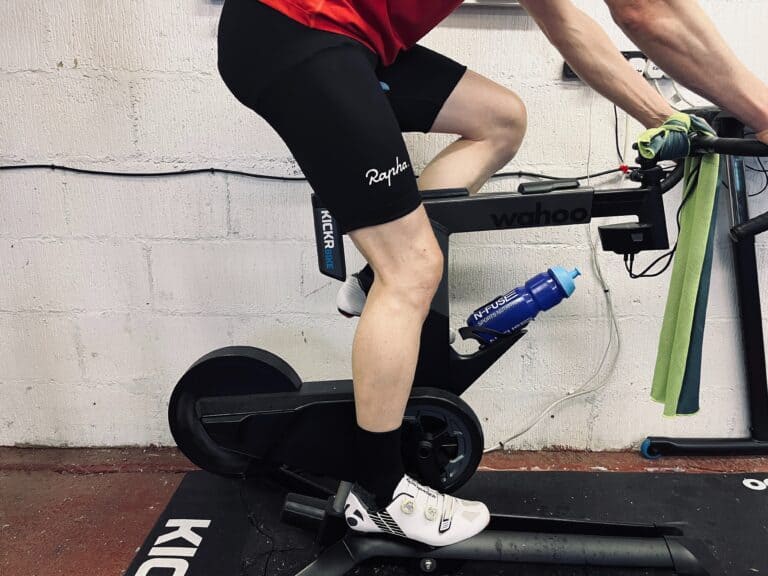There are a number of ways that you can improve your speed and endurance on the bike. These include training, getting adequate rest, fueling your body with the right nutrition and hydration, taking care of your bike, and adjusting your cycling position.
Why Do You Want to Improve Your Cycling Speed and Endurance?
I’ve never met a cyclist that wanted to get slower on their bicycle. On the other hand, most – if not all – of us really want to get faster!
In this article, we’re going to talk about some of the things that you can do to get faster and improve your endurance while cycling. Some of them, like training, will take time, while others – like your cycling position – may have instant effects on your speed. Let’s get started.
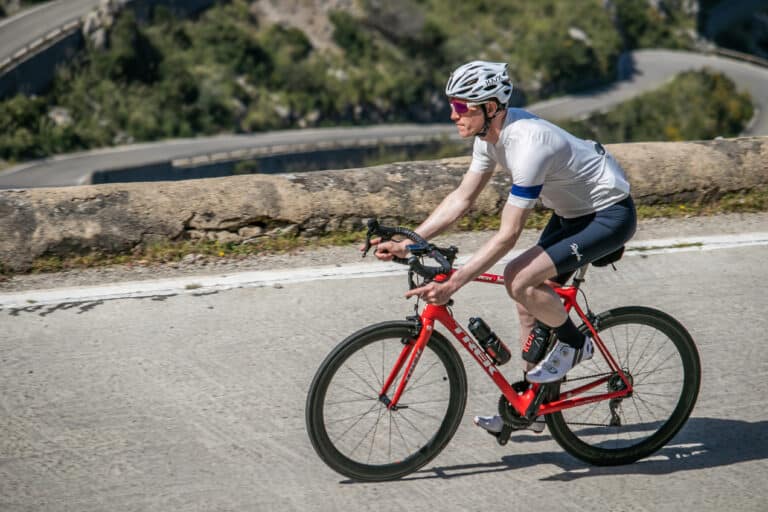
Key Takeaways
- Fueling with the right nutrition will boost your energy and enable you to go further/faster
- Rest is just as important as training, so get the balance right
- Keep your bike well-maintained so it’s not a friction drag
- On and off-bike strength training delivers complementary results
- Group riding will encourage you, and provide some competition
Nutrition and Hydration
Your body has enough energy stores to get you through about an hour of hard riding. However, you won’t perform your best if your daily nutrition and hydration are lacking. Endurance athletes are often under a lot of pressure to consume fewer calories so they can maintain their ‘race weight.’ But for the typical competitive but non-pro cyclist, this can actually be harmful.
We need to make sure that we are eating enough of the right foods every day. Most of us need a good balance of protein, carbohydrates, and fats alongside lots of fruits and vegetables. Protein encourages muscle growth, carbohydrates give us energy, fats help us feel satiated, and fruits and vegetables give us all kinds of vitamins and nutrients.
If you don’t eat enough calories, you can end up feeling fatigued, and you’ll end up getting slower, instead of faster. Ideally, you’ll talk to a coach, nutritionist, or doctor for the best eating strategy for your situation. But don’t underestimate the power of good nutrition and enough calories to fuel your workouts, both on and off the bike.
Also important is hydration. Staying well hydrated while you are riding and even when you’re not will help you keep your energy levels up. If you get dehydrated, you’ll be fatigued, and you just won’t be able to ride as fast or as long as you would if you had enough hydration.
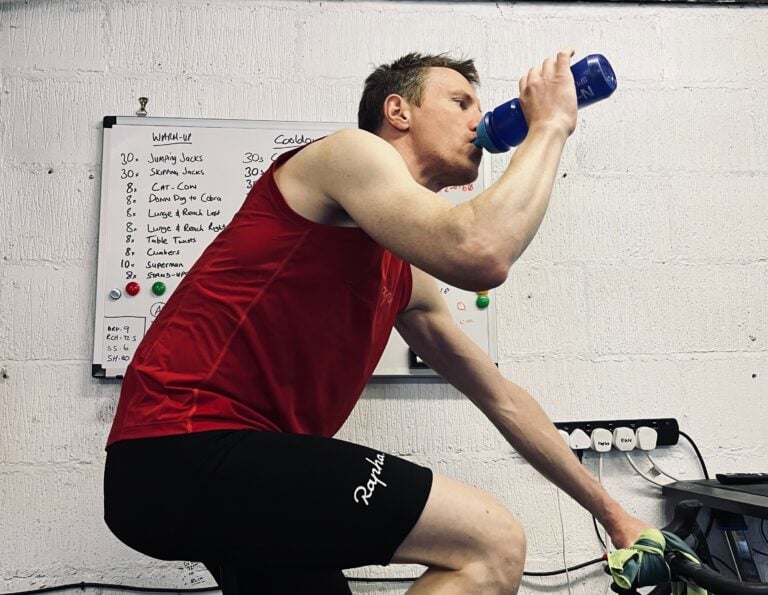
Adequate Rest
As a busy mom, I’m often guilty of staying up too late just to have a little bit of time for myself. But athletes need rest! If your sleep is suffering, your cycling performance will, too.
One night of bad sleep will make your rate of perceived exertion feel much harder than it normally would, although it probably won’t affect your strength. However, if you have a chronic sleep deficit, your body won’t be able to repair itself overnight, so you won’t be able to build muscle and get stronger. In addition, over time, lack of sleep will slow you down. So if you want to ride faster, rest up!
Athletes probably need about 7 to 9 hours of good solid sleep every night. If you have trouble sleeping, you might want to try reducing your caffeine intake. In the evening, turn off your electronic devices (yes, I’m talking about cell phones and iPads) for at least an hour before going to bed. Create a relaxing bedtime routine that tells your body it’s time for rest. Don’t eat a big meal right before bed – indigestion can keep you awake! Instead, a light snack with a little protein might be just the thing to help you sleep through the night.
If you still have sleep issues, you might need to consider any underlying health problems, such as sleep apnea or asthma, which could be interrupting your sleep.
Bike Condition
The bike you ride can greatly affect how fast you go! Of course, a race bike is made for speed, so you’ll naturally go faster on a race bike than you would on a more comfortable, heavier hybrid bike. But there are a few things about your bike that will help you go faster, too.
Keep your bike clean
If your bike is dirty, it could slow you down. For example, bikeradar.com says that a dirty bike chain can cause a 1 to 2% loss of power over the course of your ride. Keeping your chain clean and lubed, then, will help you go faster!
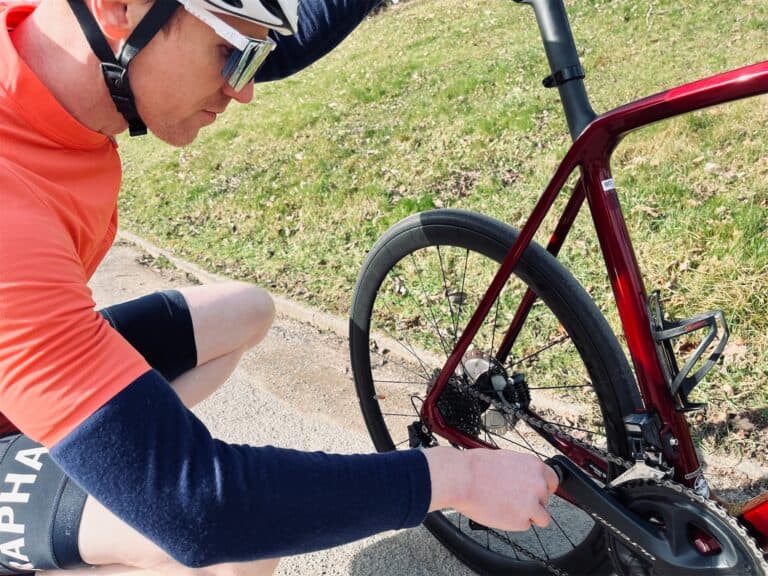
Use the right tires
Tires have a big effect on speed, so use the right tires for the terrain. The rougher the terrain, the wider the tires you’ll need to use. So if you’re riding on gravel, 38 to 40 knobby gravel tires will help you go faster. On the road, though, you’ll want to stick to a tire that is somewhere around 25 to 28mm and slick. Bigger tires roll more slowly, so use thinner tires to speed up.
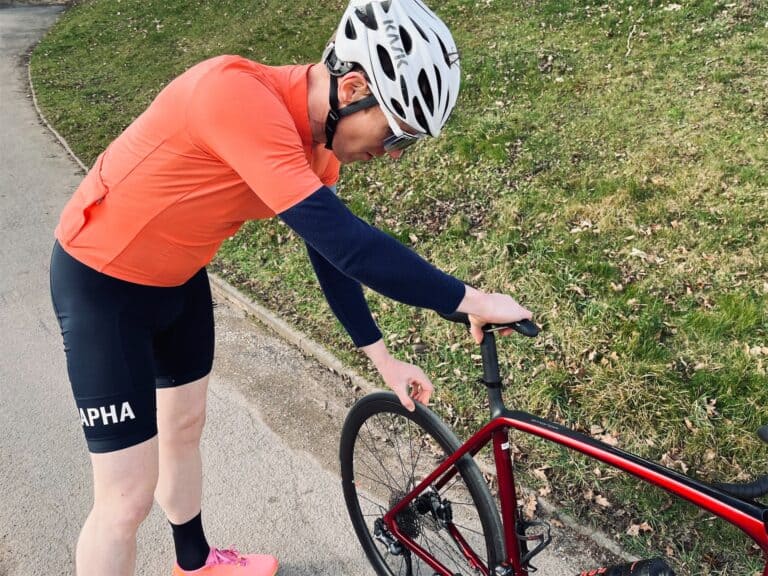
Use the right tire pressure
If your tire pressure is too low, you’ll roll slowly and be at risk for punctures. On the other hand, if your tire pressure is too high, your ride will be bouncy, and you’ll waste energy. So find the sweet spot for tire pressure for optimum speed.
Don’t overload your bike
I once met a couple on the road who rode gravel bikes with panniers to carry all the ‘stuff’ they thought they needed – for a two-hour ride. They were completely overloaded with stuff that simply slowed them down.
If you want to speed up, take off any unnecessary items from your bike. For example, if your bike is weighed down with all kinds of ‘stuff’ like handlebar bags, frame bags, and other types of stuff, it will slow you down because your bike will be heavier and less aerodynamic. Bring the essentials that you need for a good, safe ride– water, nutrition, and whatever tools or items you need to change a flat – just don’t bring along everything and the kitchen sink.
Cycling Position
You can immediately increase your speed by adjusting your position on the bike. If you tend to ride in an upright position, you’ll catch more wind which slows you down. On the other hand, if you ride in a more aggressive position, you’ll be more aerodynamic. Try to ride with your back flatter, your elbows tucked in, and your knees pointed straight ahead for the most aerodynamic position (as long as you can do it safely and comfortably).
Make sure your bike fits you well. A poorly fitting bike will waste your energy, so dialing in your bike fit will help you put all of the power to the pedals. If you need help, call your local bike shop to get in for a professional bike fitting.
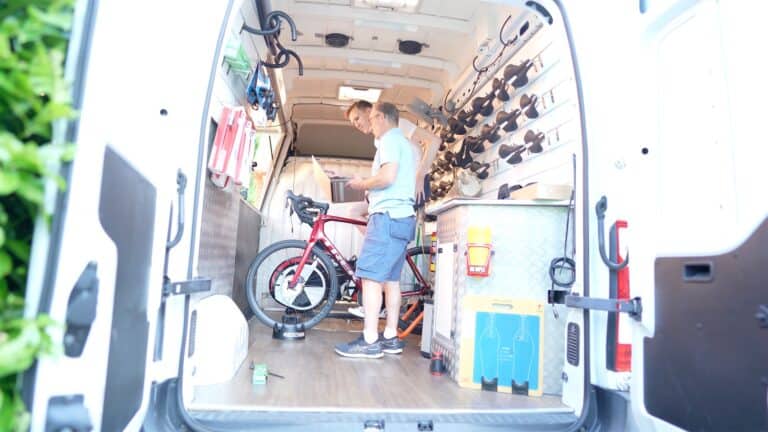
Training for Speed and Endurance
Our bodies are amazingly adaptive. The drawback, though, is that our bodies adjust to the stresses we put on it. So if we always do the same workout at the same intensity, we’ll eventually stop improving unless we add more or different types of stress. We also need adequate recovery so that our bodies can repair and make those necessary adaptations to handle the workload.
Everyone’s training plan will differ because everyone has different strengths, weaknesses, and recovery needs. However, after talking with a few coaches, there is a theme that you can see in how a good training plan works.
Be advised that I’m not a coach, and I can’t guarantee you any kind of success. But what I can do is show you what worked for me over the past year.
My own fall/ winter training plan looked something like this:
- 1 sprint workout per week
- 1 VO2 Max workout or race per week
- 1 recovery workout per week
- 2 to 3 long, easy rides per week
- 2 calisthenic workouts per week, usually on long ride days
I would do these workouts with increasing intensity for 3 weeks, then lower the intensity and number of miles for a week, then start the process again.
When I started racing track for the summer, my training changed, but I continued to make even more progress. It looked like this:
- 2.5 hours of hard training sessions per week, which included warmups, sprint drills, race drills, and cooldowns
- 1 set of races per week
- 2 complete days off
- 2 days of easy-ish but long rides
- One light calisthenics workout per week to maintain strength
Occasionally, I would have a lighter week with less riding to catch up on rest.
Both types of training were effective for me, for now. Over time, I’ll need to dial in my training with more specific workouts and guides. However, there are several things these training plans had in common.
- Consistency
- Strength workouts
- 2 to 3 hard workouts that push me past my limit
- 2 to 3 Long, easy rides
- Rest
Consistency
First of all, training needs to be pretty consistent. If you only train once or twice a month, you won’t get better, and you might not even be able to maintain what you already have. You need to train several times a week to get stronger and faster.
And while life certainly can get in the way of cycling, you still need some kind of regular training to make progress.
Strength Training
Strength workouts improve your cycling in a number of ways. First of all, just increasing leg strength will help you turn over a harder gear with the same effort. Second, strength workouts will help you with balance and stability and will help to prevent repetitive use injuries. For example, if you hit a pothole and lose your grip on the bars, you have a much better chance of staying upright if you have a good strong core.
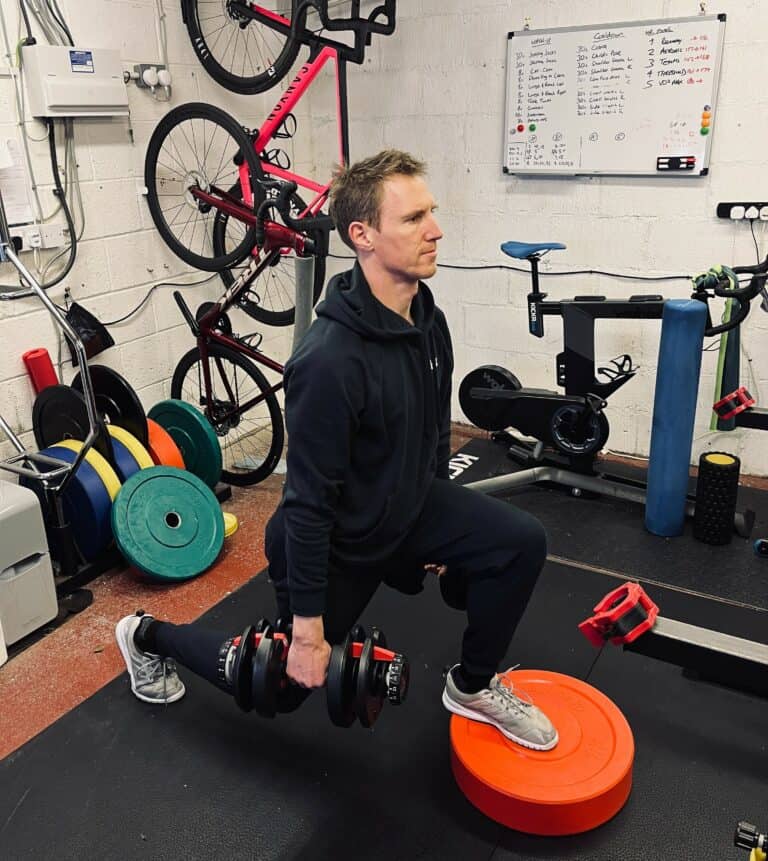
Hard Workouts
Hard workouts are critical in the right dose. Most people can handle two or maybe even three hard workouts per week. Any more than that, and you risk overtraining or hurting yourself. If you try to hammer every time you ride, you’ll wear yourself out. So just the right amount of these workouts at a hard intensity will help you get faster and improve your endurance.
A great way to get these right is to use an indoor trainer with a cycling platform such as Zwift, Wahoo X, Xert, Training Peaks, or Sufferfest. Each of these programs has its own metrics for measuring how hard you need to train to get faster and provide the workout structure to get you there. Better yet, have a coach like Simon from Velo Performance CC set up these workouts for you.
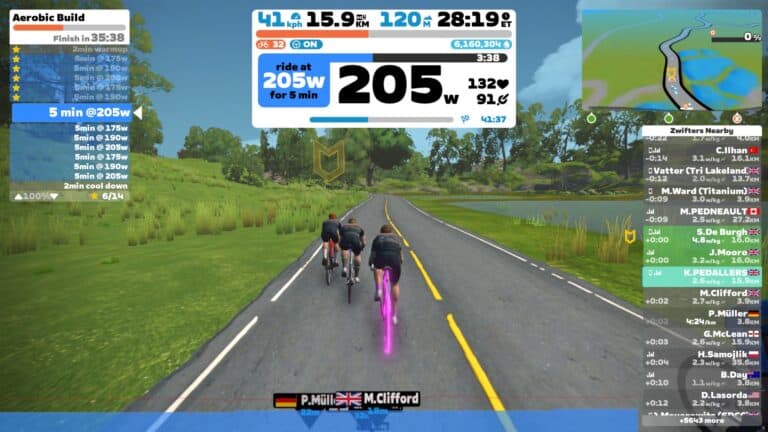
Long, easy rides
Surprisingly, you need to slow down to get faster! Without getting too deep into the science, long, easy rides – in the ballpark of 45 or 50 miles – will increase your body’s aerobic capacity at the cellular level. You can also use long easy rides to practice your nutrition and hydration strategies.
Rest
You need to have rest each week for your body to recover and rest each month, so you don’t end up overtraining. During the rest times, your body recovers and gets stronger! So remember that rest is just as important as the workout.
A Few Other Tips on How to Ride Faster and Longer
Play Music
If you’re riding indoors on a trainer, you can sometimes go faster and longer by playing music that motivates you.
Ride with faster people
If you want to get faster, try riding with faster people! If you are worried about getting dropped, try an online ride such as Zwift. Then, just pick a ride that is a little bit faster than your comfort zone. Or pick an IRL ride that is a little too fast and hang on for as long as you can. Then, the next week, do it again and try to hang on for just a little bit longer. If you can hang on a little bit longer every week, eventually, you’ll be able to keep up the speed for the entire ride.
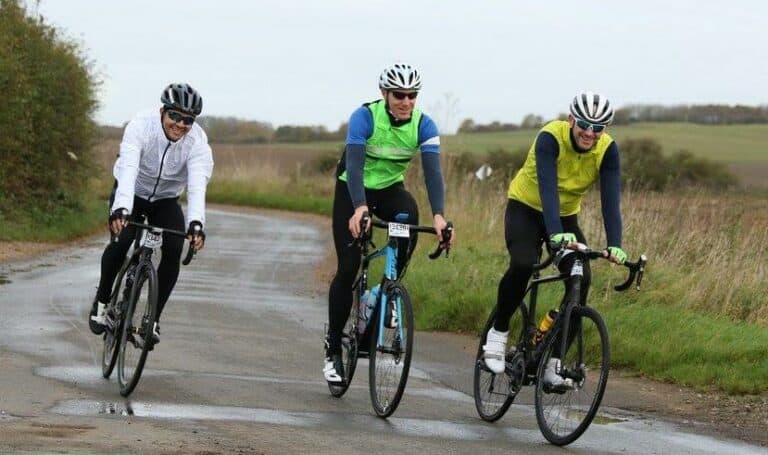
Finally, don’t give up!
If you want to get faster, get out there and ride. Ride fast, ride slow, set some goals, eat well, and rest well. If you need help, find a coach to consult who can give you direction in your training so you can achieve your goals.
FAQs for Improving Cycling Speed and Endurance
How long does it take to build up endurance for cycling?
The amount of time it takes to build up endurance for cycling depends on several factors, including your starting fitness level, your training regimen, and your nutrition and recovery practices.
It is generally recommended to start gradually and build up your endurance over time, rather than pushing yourself too hard too soon. This may involve starting with shorter, less intense rides and gradually increasing the distance and intensity of your rides.
Consistency is also key to building endurance, so it is important to establish a regular training routine and stick to it. Additionally, incorporating other forms of cross-training, such as strength training and yoga, can also help improve endurance by strengthening the muscles used in cycling and promoting overall fitness and flexibility.
With consistent training and proper nutrition and recovery practices, it is possible to build endurance for cycling in a matter of weeks to several months.
What is a good average speed for cycling?
The average speed for cycling varies depending on several factors, including the rider’s fitness level, the terrain, the weather conditions, and the type of bike being ridden.
As a general rule of thumb, recreational or beginner cyclists typically average around 10-14 miles per hour on flat terrain. More experienced or trained cyclists can typically maintain higher speeds, averaging around 15-20 mph.
Professional or elite cyclists can maintain even higher speeds, averaging around 25-28 mph.
How do I increase my leg speed for cycling?
Increasing leg speed, also known as cadence, is an important aspect of improving cycling performance, and there are several strategies you can use to increase your leg speed for cycling.
One approach is to incorporate interval training into your cycling routine, where you alternate between periods of high-intensity effort and recovery. This can help improve your leg speed and endurance over time.
Another strategy is to focus on your pedal stroke and aim for a smooth, fluid motion that utilizes all of your leg muscles.
You can also try incorporating strength training exercises, such as squats and lunges, to improve the power and efficiency of your pedal stroke.
If you are focused on leg speed, then it’s important to use a cadence sensor to monitor and track your progress over time – if you don’t measure it you can’t improve it!
